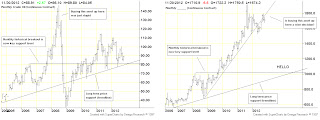Hello and welcome back to CRI's CTS Spotlight Blog.
02/15/13: In what
seems to be a straight move out of the Yen and back into the EuroFx, the
US dollar index has gone rather sideways of late (with maybe a new
slight downside bias). As the Yen itself has entered a weekly oversold
condition (rather rare in itself) regional stock markets have either hit
or exceeded upside price objectives. Indeed, stocks globally have
enjoyed a rather market friendly fundamental backdrop through Q1\'13 so
far. Seeming to confirm this, the market's classic fear proxy, gold,
hasn't fared well of late. Indeed, recent warnings regarding gold seem
to have been warranted; but now that weekly downside objectives have
been hit appreciably lower prices from current levels (for the time
being) may be asking a bit much. Recent talk of Germany 'being more
like Spain' and Japan's intention of spending their way out of their
current economic malaise suggests global fiscal austerity may be nearing
an end. Lastly, this week\'s CTS blog spotlight takes a look at another
long term commodity price chart that looks a little top heavy - Feeder
Cattle. While it may not have broken down yet, does further upside price
appreciation seem realistic?

Every once in a while it pays to keep an eye on the longer term price charts just to keep yourself honest. We all love bull markets, but at some point we have to ask ourselves if further upside price appreciation is both realistic and warranted.
Recently, we here at WCTS Blog took a look at the long term price chart of Crude Oil (as a leading commodity)and asked aloud if such a price pattern could be in gold's future (a lagging commodity). While gold seems to have begun its slow correction phase (with plenty of ebb and flow over the coming months/quarters ahead) playing commodities short through the 17.5 fear cycle (of which we are currently in year 12-13) can be very profitable but also dangerous too. Indeed, I would expect short term rallies (back into resistance) to be violent and profit windows on short positions to open and close very quickly. While I love the notion of our 'home-run-trade' ($110 Dec. '13 Put option on GLD), I wouldn't be looking to touch that position unless it doubles in value (at which point it is always a good idea to sell half your position).
Having said that, I think the more important question traders ought to be asking themselves is does ownership of gold at +$1500/oz represent a cheap or expensive holding? Considering our long time held technical belief in the 50% rule, long term ownership of any commodity well above that level is inevitably asking for trouble. Additionally, we as asset owners are not only looking for stable prices but indeed we need rising prices. Without rising prices there can be no capital gain, which makes this entire endevour pointless. So not only do we need to ask if ownership is risky but also ask if capital gain potential is realistic. Unfortunatly, when it came to +$1,700 gold that simply was not the case - for the time being.
Which brings us to our commodity in focus this week, Feeder Cattle. Without a doubt, Feeder Cattle has enjoyed a rather noticeably rally over the past four years. at +130 weeks it has been by far the longest running weekly bull pattern WCTS has followed in its short history. Prices briefly tested the key lows under $90 in 2009 only to peak just above $160 into early 2012. The historical breakout through $120 represented a significant re-pricing of Feeder Cattle and in the face of topping grain prices, farmers had little new incentive to bring product to market. As long as price remained above the very powerful short term uptrend line, there really was no telling where she was going. But with the recent weekly failure just below that significant uptrend line, one has to seriously be asking themselves if further upside objectives are realistic? At the moment, price is caught in a channel (133 to 155) and it is really a coin toss in the short term as to which mark will be traded at next. The point here is, does owning Feeder Cattle represent a low risk or high risk proposition? Considering many institutional traders watch for the OTE Fibonacci levels for 'low risk' trade entries (a 70.5% retracement of the primary move & currently near the 108 area) one might argue there is realistically more than $35 (or 25%) of risk owning Feeder Cattle at these levels. That's a lot of risk!
Indeed, it is so much risk one might consider a Put option at some point along the road here. Playing the short side during 17.5 year 'fear cycles' (as pointed out previously) can be both rewarding and dangerous. Like the GLD Put recommendation made earlier, this would be a very long term trade for commodity options and as a 'home-run' trade ought to be treated as so. That means it ought to be only considered with money that you can afford to lose. While Feeder Cattle's potential monthly top is still early in the making I shall be watching for a an OnlyDoubles trade possibility and will of course keep you all informed should one come along.
Speaking of which, our last OnlyDoubles trade seems to be working nicely as bond prices within the US continue their correction. June TLT 120 Puts suggested at $4.00 are currently $7.00. Those that were able to take the trade ought to have orders working at double your purchase price (hence the name OnlyDoubles!) or at $8.00 or better. Once filled on half the position (and you have your original investment capital back in your hands) feel free to ride the remaining to where ever your personal comfort level takes you.
That's all for this issue of the CTS Spotlight,
Brian Beamish FCSI
The Canadian Rational Investor
the_rational_investor@yahoo.com







